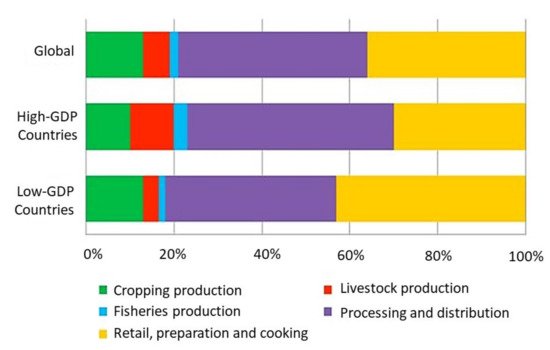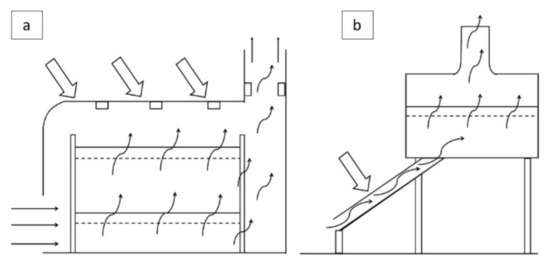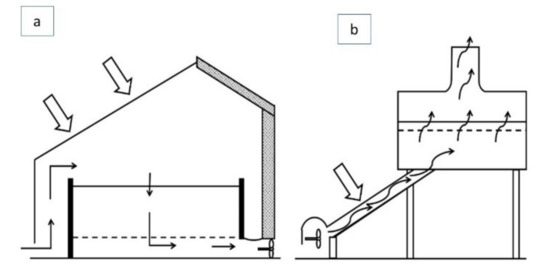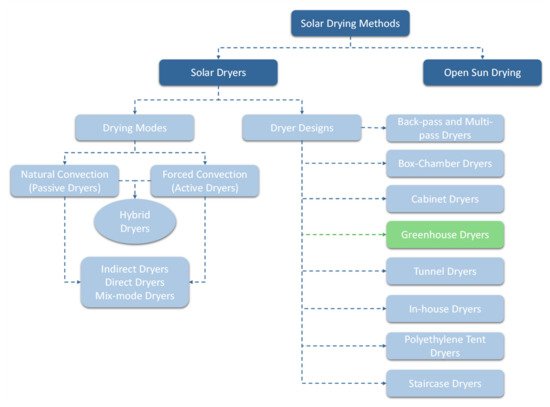
| Version | Summary | Created by | Modification | Content Size | Created at | Operation |
|---|---|---|---|---|---|---|
| 1 | Shiva Gorjian | + 1969 word(s) | 1969 | 2021-06-30 08:19:15 | | | |
| 2 | Bruce Ren | -21 word(s) | 1948 | 2021-07-01 08:16:52 | | |
Video Upload Options
Greenhouse dryers (GHDs) are simple facilities that can provide large capacities for drying agricultural products. The solar GHDs (SGHDs) are classified as passive and active systems. The passive SGHDs have a heat transfer through natural convection, whereas, SGHDs having a heat transfer through forced convection are called active dryers. Active SGHDs can be integrated with different solar technologies, including photovoltaic (PV), photovoltaic-thermal (PVT), and solar thermal collectors. Additionally, solar-assisted greenhouse dryers (SGHDs) can be integrated with heat pumps and thermal energy storage (TES) units and presented in hybrid configuration considering their integration with other renewable energy sources with the aim of improving the thermal performance.
1. Introduction

2. Solar-Assisted Dryers for Agricultural and Marine Products
2.1. Open Sun Drying

2.2. Passive Solar Dryers

2.3. Active Solar Dryers

2.4. Hybrid Solar Dryers
References
- United Nations DESA. World Population Prospects 2019; United Nations: San Francisco, CA, USA, 2019.
- Gorjian, S.; Ebadi, H. Introduction. In Photovolt. Sol. Energy Convers; Shukla, S.G.A.E., Ed.; Elsevier: Amsterdam, The Netherlands, 2020; pp. 1–26.
- Gorjian, S.; Ebadi, H.; Trommsdorff, M.; Sharon, H.; Demant, M.; Schindele, S. The advent of modern solar-powered electric agricultural machinery: A solution for sustainable farm operations. J. Clean Prod. 2021, 292, 126030.
- Technical Platform on the Measurement and Reduction of Food Loss and Waste|Food and Agriculture Organization of the United Nations. Available online: (accessed on 8 January 2021).
- Melikoglu, M. Reutilisation of food wastes for generating fuels and value added products: A global review. Environ. Technol. Innov. 2020, 19, 101040.
- Chegere, M.J. Post-harvest losses reduction by small-scale maize farmers: The role of handling practices. Food Policy 2018, 77, 103–115.
- Awasthi, S.K.; Sarsaiya, S.; Awasthi, M.K.; Liu, T.; Zhao, J.; Kumar, S.; Zhang, Z. Changes in global trends in food waste composting: Research challenges and opportunities. Bioresour. Technol. 2020, 299, 122555.
- Lingayat, A.B.; Chandramohan, V.P.; Raju, V.R.K.; Meda, V. A review on indirect type solar dryers for agricultural crops—Dryer setup, its performance, energy storage and important highlights. Appl. Energy 2020, 258, 114005.
- Babu, A.K.; Kumaresan, G.; Raj, V.A.A.; Velraj, R. Review of leaf drying: Mechanism and influencing parameters, drying methods, nutrient preservation, and mathematical models. Renew. Sustain. Energy Rev. 2018, 90, 536–556.
- Llavata, B.; García-Pérez, J.V.; Simal, S.; Cárcel, J.A. Innovative pre-treatments to enhance food drying: A current review. Curr. Opin. Food Sci. 2020, 35, 20–26.
- Kagande, L. Design and performance evaluation of solar tunnel dryer for tomato fruit drying in Zimbabwe. IOSR J. Eng. 2012, 2, 1–7.
- Gorjian, S.; Singh, R.; Shukla, A.; Mazhar, A.R. On-farm applications of solar PV systems. In Photovoltaic Solar Energy Conversion; Gorjian, S., Shukla, A., Eds.; Elsevier: Amsterdam, The Netherlands, 2020; pp. 147–190.
- Walsh, M.J.; Gerber Van Doren, L.; Shete, N.; Prakash, A.; Salim, U. Financial tradeoffs of energy and food uses of algal biomass under stochastic conditions. Appl. Energy 2018, 210, 591–603.
- Fayose, F.; Huan, Z. Heat Pump Drying of Fruits and Vegetables: Principles and Potentials for Sub-Saharan Africa. Int. J. Food Sci. 2016, 2016, 9673029.
- Sims, R.E.H. “Energy-Smart” Food for People and Climate; FAO: Rome, Italy, 2011.
- Monforti-Ferrario, F.; Dallemand, J.-F.; Pascua, I.P.; Motola, V.; Banja, M.; Scarlat, N.; Bertoldi, P.; Pennington, D. Energy Use in the EU Food Sector: State of Play and Opportunities for Improvement; Publications Office of the EU: Luxembourg, 2015.
- Singh, P.L. Silk cocoon drying in forced convection type solar dryer. Appl. Energy 2011, 88, 1720–1726.
- Azaizia, Z.; Kooli, S.; Hamdi, I.; Elkhal, W.; Guizani, A.A. Experimental study of a new mixed mode solar greenhouse drying system with and without thermal energy storage for pepper. Renew. Energy 2020, 145, 1972–1984.
- Sharma, A.; Chen, C.R.; Vu Lan, N. Solar-energy drying systems: A review. Renew. Sustain. Energy Rev. 2009, 13, 1185–1210.
- Kemp, I.C. Fundamentals of Energy Analysis of Dryers. Mod. Dry Technol. 2012, 4, 1–45.
- Salehi, F. Recent Applications and Potential of Infrared Dryer Systems for Drying Various Agricultural Products: A Review. Int. J. Fruit Sci. 2020, 20, 586–602.
- Tigampo, S.; Sambou, V.; Dieye, Y.; Toure, P.M.; Bodian, S. Study of air movement and temperature distribution in a greenhouse used as a dryer. MATEC Web Conf. 2020, 307, 01051.
- El Hage, H.; Herez, A.; Ramadan, M.; Bazzi, H.; Khaled, M. An investigation on solar drying: A review with economic and environmental assessment. Energy 2018, 157, 815–829.
- Yildizhan, H.; Taki, M.; Özilgen, M.; Gorjian, S. Renewable energy utilization in apple production process: A thermodynamic approach. Sustain. Energy Technol. Assess. 2021, 43, 100956.
- Gorjian, S.; Minaei, S.; MalehMirchegini, L.; Trommsdorff, M.; Shamshiri, R.R. Applications of solar PV systems in agricultural automation and robotics. In Photovoltaic Solar Energy Conversion; Gorjian, S., Shukla, A., Eds.; Elsevier: Amsterdam, The Netherlands, 2020; pp. 191–235.
- Janjai, S.; Khamvongsa, V.; Bala, B.K. Development, design, and performance of a PV-Ventilated greenhouse dryer. Int. Energy J. 2007, 8, 249–258.
- Azaizia, Z.; Kooli, S.; Elkhadraoui, A.; Hamdi, I.; Guizani, A. Investigation of a new solar greenhouse drying system for peppers. Int. J. Hydrogen Energy 2017, 42, 8818–8826.
- Hamdi, I.; Kooli, S.; Elkhadraoui, A.; Azaizia, Z.; Abdelhamid, F.; Guizani, A. Experimental study and numerical modeling for drying grapes under solar greenhouse. Renew. Energy 2018, 127, 936–946.
- Iskandar, A.N.; Ya’acob, M.E.; Anuar, M.S. Tropical field performance of dual-pass PV tray dryer. AIP Conf. Proc. 2017, 020016.
- Eltawil, M.A.; Azam, M.M.; Alghannam, A.O. Energy analysis of hybrid solar tunnel dryer with PV system and solar collector for drying mint (MenthaViridis). J. Clean Prod. 2018, 181, 352–364.
- Amer, B.M.A.; Gottschalk, K.; Hossain, M.A. Integrated hybrid solar drying system and its drying kinetics of chamomile. Renew. Energy 2018, 121, 539–547.
- Fudholi, A.; Sopian, K.; Ruslan, M.H.; Alghoul, M.A.; Sulaiman, M.Y. Review of solar dryers for agricultural and marine products. Renew. Sustain. Energy Rev. 2010, 14, 1–30.
- Udomkun, P.; Romuli, S.; Schock, S.; Mahayothee, B.; Sartas, M.; Wossen, T.; Njukwe, E.; Vanlauwe, B.; Müller, J. Review of solar dryers for agricultural products in Asia and Africa: An innovation landscape approach. J. Environ. Manag. 2020, 268, 110730.
- Banout, J. Solar Drying Systems. Solar Drying Technology, Green Energy and Technology; Springer: Singapore, 2017; pp. 39–67.
- Tiwari, S.; Tiwari, G.N.; Al-Helal, I.M. Development and recent trends in greenhouse dryer: A review. Renew. Sustain. Energy Rev. 2016, 65, 1048–1064.
- Mustayen, A.G.M.B.; Mekhilef, S.; Saidur, R. Performance study of different solar dryers: A review. Renew. Sustain. Energy Rev. 2014, 34, 463–470.
- Kumar, M.; Sansaniwal, S.K.; Khatak, P. Progress in solar dryers for drying various commodities. Renew. Sustain. Energy Rev. 2016.
- Seveda, M.S.; Jhajharia, D. Design and performance evaluation of solar dryer for drying of large cardamom (Amomum subulatum). J. Renew. Sustain. Energy 2012.
- Jain, D.; Tiwari, G.N. Effect of greenhouse on crop drying under natural and forced convection II. Thermal modeling and experimental validation. Energy Convers. Manag. 2004.
- Tomar, V.; Tiwari, G.N.; Norton, B. Solar dryers for tropical food preservation: Thermophysics of crops, systems and components. Sol. Energy 2017.
- Tsotsas, E.; Mujumdar, A.S. Modern Drying Technology; John Wiley & Sons: Hoboken, NJ, USA, 2014.
- Tsotsas, E.; Mujumdar, A.S. Modern Drying Technology Vol. 1 Computational Tools at Different Scales. Dry Technol. 2008.
- Tiwari, S.; Tiwari, G.N.; Al-Helal, I.M. Performance analysis of photovoltaic–thermal (PVT) mixed mode greenhouse solar dryer. Sol. Energy 2016, 133, 421–428.
- Tiwari, S.; Tiwari, G.N. Exergoeconomic analysis of photovoltaic-thermal (PVT) mixed mode greenhouse solar dryer. Energy 2016, 114, 155–164.
- Tiwari, S.; Tiwari, G.N. Energy and exergy analysis of a mixed-mode greenhouse-type solar dryer, integrated with partially covered N-PVT air collector. Energy 2017, 128, 183–195.
- Tiwari, A. A Review on Solar Drying of Agricultural Produce. J. Food Process. Technol. 2016.
- El-Sebaii, A.A.; Shalaby, S.M. Solar drying of agricultural products: A review. Renew. Sustain. Energy Rev. 2012, 16, 37–43.
- Mujumdar, A. Principles, Classification, and Selection of Dryers. In Handbook of Industrial Drying, 3th ed.; CRC: Boca Raton, FL, USA, 2006.
- Prakash, O.; Kumar, A. Historical Review and Recent Trends in Solar Drying Systems. Int. J. Green Energy 2013, 10, 690–738.
- Ghatrehsamani, S.H.; Dadashzadeh, M.; Zomorodian, A. Kinetics of apricot thin layer drying in a mixed and indirect mode solar dryer. Int. J. Agric. Sci. 2012, 4, 262–267.
- Bala, B.K.; Woods, J.L. Simulation of the indirect natural convection solar drying of rough rice. Sol. Energy 1994.
- Simate, I.N. Optimization of mixed-mode and indirect-mode natural convection solar dryers. Renew. Energy 2003.
- Simate, I.N. Simulation of the mixed-mode natural-convection solar drying of maize. Dry Technol. 2001.
- Lamrani, B.; Draoui, A. Modelling and simulation of a hybrid solar-electrical dryer of wood integrated with latent heat thermal energy storage system. Therm. Sci. Eng. Prog. 2020.
- Mohammed, S.; Fatumah, N.; Shadia, N. Drying performance and economic analysis of novel hybrid passive-mode and active-mode solar dryers for drying fruits in East Africa. J. Stored Prod. Res. 2020.
- Reyes, A.; Mahn, A.; Cubillos, F.; Huenulaf, P. Mushroom dehydration in a hybrid-solar dryer. Energy Convers. Manag. 2013.
- Gudiño-Ayala, D.; Calderón-Topete, Á. Pineapple drying using a new solar hybrid dryer. Energy Procedia 2014.
- Dhanushkodi, S.; Wilson, V.H.; Sudhakar, K. Mathematical modeling of drying behavior of cashew in a solar biomass hybrid dryer. Resour. Technol. 2017.





